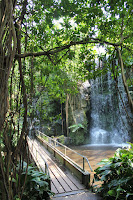One month ago, as my plane was landing in Chicago and I listened to a girl behind me tell a European that Michigan was "so hilly" (nice sentiment, but
not true), I could hardly believe that I had just spent nearly two months in Europe. Where had the time gone? It felt like yesterday that I had showed up in Germany and followed a tall blonde woman around everywhere. Today, it still feels like a dream as random memories keep coming back and I think,
Oh yeah, I was actually there. Bonn, Cologne, Paris, Hannover, Berlin, Prague, Büsum, Copenhagen, Utrecht, Amsterdam, Edinburgh, London, Gießen, Marburg. 6 countries in 7 weeks. It sounds like a long time, and towards the end, I was indeed looking at my "turtle shell" backpack with disdain and starting to miss home. The last night in Germany was 100 degrees, on a top floor apartment with no AC or even fans (why, Europe?
Why??), so I did not sleep at all as I lay in a pool of my own sweat. I was ready to get on that plane - by myself, this time - and make the long, nearly 15 hour trip back to Michigan.
My connecting flight from Sweden to Chicago took about 9 hours, during which I had a broken TV and was sitting next to a family with 3 infants/toddlers that threw things (food, shoes, whatever) in my general direction and made some noise. So, I read an entire book, listened to music, and slept 0 hours. After one final flight to Detroit, I was relieved to be done traveling. Except I wasn't! My mom picked me up and drove me 4 hours to our lake house for the holiday. I chattered about my trip in a sleep-deprived delirium. My friends and relatives were all very interested in my travels, and I did my best to provide them with interesting stories and my experiences. The question I seem to get the most is, "What was your favorite place?" It's difficult to answer because I liked different things about each place - Germany was the most interesting, Scotland was beautiful, the Dutch students were so accommodating, Prague was very vibrant. I honestly did not feel much of an adjustment or weird about coming back to American society; it just felt like home.
My insights about the differences between American and European society are probably not anything new or inspired, but I do think that veterinary students offer a somewhat unique position. We are a little bit older than our European counterparts, a bit more educated and very much in debt, yet all of us are driven by the same desire/passion/calling to be veterinarians. As I've mentioned, vet school is different in every country, but they all start after high school and finish after 5-6 years, with or without a DVM depending on the school. And, of course, education is free. On the flip side, taxes are higher and incomes are lower in Europe. Americans are so driven by a need to succeed, work hard and earn what we deserve, which is a great ideal I share. However, I'm going to be drowning in hundreds of thousands of student loans for the rest of my life because of it. I do feel like I'm getting a better secondary education in the US, but I'm going to pay for it. Literally.
Something else I loved about Europe that is a bit obvious was all of the history right in front of your face. I felt like I was constantly learning something interesting in every place I visited. Giessen was a small and sleepy town, its Bavarian architecture destroyed in WWII, but it has one of the oldest vet schools in Europe (200 years) and invented the method of plastination for arteries and veins. Marburg is the home of the University where the Brothers Grimm studied. It's pretty interesting that a 3 hour train ride in any direction will land you in a different country with a different language, culture, and landscape. I miss living in the moment, getting lost in a new place, walking everywhere, and interacting with my international peers. I do
not miss living out of a backpack and being at the mercy of public transportation. I fell back into my life with ease, but I won't ever forget my experiences abroad. I can't wait to go back someday.
 |
| Auf Wiedersehen to Germany and my new friends from Texas, and of course Mira with her yoga posing for these group photos |
Farewell,
~Andrea























